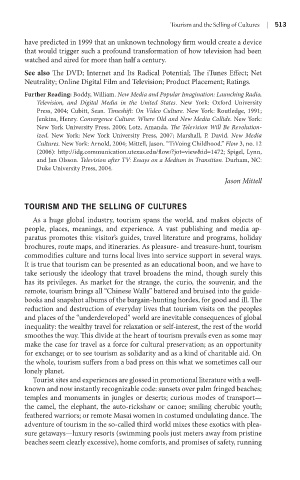Page 534 - Battleground The Media Volume 1 and 2
P. 534
Tour sm and the Sell ng of Cultures | 1
have predicted in 1999 that an unknown technology firm would create a device
that would trigger such a profound transformation of how television had been
watched and aired for more than half a century.
see also The DVD; Internet and Its Radical Potential; The iTunes Effect; Net
Neutrality; Online Digital Film and Television; Product Placement; Ratings.
Further reading: Boddy, William. New Media and Popular Imagination: Launching Radio,
Television, and Digital Media in the United States. New York: Oxford University
Press, 2004; Cubitt, Sean. Timeshift: On Video Culture. New York: Routledge, 1991;
Jenkins, Henry. Convergence Culture: Where Old and New Media Collide. New York:
New York University Press, 2006; Lotz, Amanda. The Television Will Be Revolution-
ized. New York: New York University Press, 2007; Marshall, P. David. New Media
Cultures. New York: Arnold, 2004; Mittell, Jason. “TiVoing Childhood.” Flow 3, no. 12
(2006): http://idg.communication.utexas.edu/flow/?jot=view&id=1472; Spigel, Lynn,
and Jan Olsson. Television after TV: Essays on a Medium in Transition. Durham, NC:
Duke University Press, 2004.
Jason Mittell
tourisM and the selling oF Cultures
As a huge global industry, tourism spans the world, and makes objects of
people, places, meanings, and experience. A vast publishing and media ap-
paratus promotes this: visitor’s guides, travel literature and programs, holiday
brochures, route maps, and itineraries. As pleasure- and treasure-hunt, tourism
commodifies culture and turns local lives into service support in several ways.
It is true that tourism can be presented as an educational boon, and we have to
take seriously the ideology that travel broadens the mind, though surely this
has its privileges. As market for the strange, the curio, the souvenir, and the
remote, tourism brings all “Chinese Walls” battered and bruised into the guide-
books and snapshot albums of the bargain-hunting hordes, for good and ill. The
reduction and destruction of everyday lives that tourism visits on the peoples
and places of the “underdeveloped” world are inevitable consequences of global
inequality: the wealthy travel for relaxation or self-interest, the rest of the world
smoothes the way. This divide at the heart of tourism prevails even as some may
make the case for travel as a force for cultural preservation; as an opportunity
for exchange; or to see tourism as solidarity and as a kind of charitable aid. On
the whole, tourism suffers from a bad press on this what we sometimes call our
lonely planet.
Tourist sites and experiences are glossed in promotional literature with a well-
known and now instantly recognizable code: sunsets over palm fringed beaches;
temples and monuments in jungles or deserts; curious modes of transport—
the camel, the elephant, the auto-rickshaw or canoe; smiling cherubic youth;
feathered warriors; or remote Masai women in costumed undulating dance. The
adventure of tourism in the so-called third world mixes these exotics with plea-
sure getaways—luxury resorts (swimming pools just meters away from pristine
beaches seem clearly excessive), home comforts, and promises of safety, running

